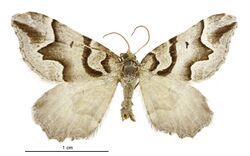Biology:Helastia expolita
| Helastia expolita | |
|---|---|

| |
| Male | |
| Scientific classification | |
| Domain: | Eukaryota |
| Kingdom: | Animalia |
| Phylum: | Arthropoda |
| Class: | Insecta |
| Order: | Lepidoptera |
| Family: | Geometridae |
| Genus: | Helastia |
| Species: | H. expolita
|
| Binomial name | |
| Helastia expolita (Philpott, 1917)[1]
| |
| Synonyms[2] | |
| |
Helastia expolita is a moth of the family Geometridae. This species is endemic to New Zealand and occurs in the Buller, Marlborough, North and Mid Canterbury regions.This species inhabits short tussock grassland in montane to subalpine zones. Adult moths are nocturnal but little is known about the life history of H. expolita. Adults have been observed on the wing in November. It has been hypothesised the larvae of H. expolita feed on the flowers of Helichrysum species and then feed on mosses, lichens or shrubs growing nearby. It is classified as "At Risk, Relict'" by the Department of Conservation.
Taxonomy
This species was first described by Alfred Philpott in 1917 using a specimen collected by J.H. Lewis at Broken River, Canterbury and named Hydriomena expolita.[3][4] George Hudson discussed and illustrated this species in his 1928 book The Butterflies and Moths of New Zealand under the same name.[5] Louis Beethoven Prout in 1939 placed this species in the genus Euphyia.[2] In 1987 Robin C. Craw placed this species within the genus Helastia.[2] The holotype specimen is held at the New Zealand Arthropod Collection.[4]
Description
Philpott described the species as follows:
♂︎. 30 mm. Head, palpi, and antennae purplish-grey. Thorax fuscous-brown mixed with grey. Abdomen fuscous-grey with some reddish scales laterally. Forewings moderate, triangular, costa moderately arched, apex subacute, termen sinuate, oblique ; whitish-grey with faint purplish tinge ; markings dark purplish-fuscous ; basal line thick, evenly curved, projecting angularly at middle ; anterior margin of median band inwardly oblique beneath costa at 1⁄3, thence broadly excurved to dorsum at 1⁄4 ; posterior margin from 2⁄3 costa to 3⁄4 dorsum, with strong broad apically-indented projection at middle ; traces of a thin waved white subterminal line ; an oblique suffused purplish-fuscous fascia from apex : cilia grey, obscurely barred with fuscous, tips whitish. Hindwings elongate, termen angularly projecting at middle ; purplish-grey ; basal half darker, being marked off by a median fascia parallel to termen : cilia as in forewings. Undersides : Forewings ochreous-reddish with the upper markings faintly reproduced ; hindwings ochreous-reddish, terminal half suffused with whitish.[3]
Distribution
This species is endemic to New Zealand.[6][1] It occurs in Buller, Marlborough, North Canterbury and Mid Canterbury.[2]
Biology and lifecycle
Very little is known about the biology of H. expolita.[7] Adults are nocturnal and have been collected when on the wing in November.[2]
Host species and habitat
This species prefers short tussock grassland habitat in montane to subalpine zones.[2][7] The host species for the larvae of H. expolita is unknown.[8] It has been hypothesised the larvae of H. expolita feed on the flowers of Helichrysum species and then feed on mosses, lichens or shrubs growing nearby.[9]
Conservation status
This moth is classified under the New Zealand Threat Classification system as being "At Risk, Relict".[10] The decline in the area and quality of this species habitat is one of the factors putting this species at risk.[7]
References
- ↑ 1.0 1.1 "Helastia expolita (Philpott, 1917)". Landcare Research New Zealand Ltd. http://www.nzor.org.nz/names/d2aafae2-c959-4390-8b62-51b8ec8ae6d5.
- ↑ 2.0 2.1 2.2 2.3 2.4 2.5 Craw, R. C. (1987). "Revision of the genus Helastia sensu stricto with description of a new genus (Lepidoptera: Geometridae: Larentiinae).". New Zealand Journal of Zoology 14 (2): 269–293. doi:10.1080/03014223.1987.10422997.
- ↑ 3.0 3.1 Philpott, A. (1917). "Descriptions of new species of Lepidoptera" (in en). Transactions and Proceedings of the New Zealand Institute 49: 239–245. https://biodiversitylibrary.org/page/3313371. Retrieved 16 May 2018.
- ↑ 4.0 4.1 Dugdale, J. S. (1988). "Lepidoptera - annotated catalogue, and keys to family-group taxa". Fauna of New Zealand 14: 181. http://www.landcareresearch.co.nz/__data/assets/pdf_file/0003/49008/FNZ14Dugdale1988150.pdf. Retrieved 16 May 2018.
- ↑ Hudson, G. V. (1928). The Butterflies and Moths of New Zealand. Wellington: Ferguson & Osborn Ltd.. pp. 98. http://www.bugz.org.nz/WebForms/ResultDetails.aspx?CurrentDoc=C7E94865-492F-45DA-9777-CC8E1E8B1438&back=true&NewDoc=true&searchType=1&SearchString=G.V.+Hudson.
- ↑ , p. 459, Wikidata Q45922947
- ↑ 7.0 7.1 7.2 Pawson, S.M.; Emberson, R.M. (2000). "The conservation status of invertebrates in Canterbury.". Conservation Advisory Science Notes 320: 1–64. https://www.doc.govt.nz/Documents/science-and-technical/casn320a.pdf.
- ↑ Patrick, Brian; Dugdale, John S. (2000). Conservation status of the New Zealand lepidoptera. Wellington, N.Z.: Department of Conservation, New Zealand. pp. 24. ISBN 978-0478218671. OCLC 154670803. https://www.doc.govt.nz/documents/science-and-technical/Sfc136.pdf.
- ↑ Patrick, Brian (2014). "Of lichens and mosses". Butterflies and Moths of New Zealand 11: 8. https://www.monarch.org.nz/wp-content/uploads/2014/11/MBNZT_Issue-11_Summer-2014_online.pdf.
- ↑ Hoare, R.J.B.; Dugdale, J.S.; Edwards, E.D.; Gibbs, G.W.; Patrick, B.H.; Hitchmough, R.A.; Rolfe, J.R. (2017). Conservation status of New Zealand butterflies and moths (Lepidoptera), 2015. Wellington, New Zealand: New Zealand Department of Conservation. p. 7. ISBN 9781988514383. http://www.doc.govt.nz/Documents/science-and-technical/nztcs20entire.pdf.
Wikidata ☰ Q13879080 entry
 |



